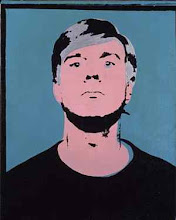 |
| Cory Arcangel, still from Colors (2005) currently on show in Tate Modern (Installation shot by maaikelauwaert taken at NIMK Amsterdam) |
My new favourite works of art found on a recent visit to Tate Modern are: Colors (2005), by Cory Arcangel, an installation by Pedro
Cabrita Reis: The Unnamed Word #1 (2005), The Moscow Piece (2006), Unframed #3 (2008), and Light Music (1975) by Lis Rhodes
Cory Arcangel’s Colors,
is a reworking of Dennis Hopper’s 1988 film of that name; Arcangel’s version
projects it one horizontal line of pixels at a time (stretched vertically to
fill the entire screen); the film plays through in real time, (the soundtrack
is unchanged), but it takes 33 days to work through screenings of all the 404 horizontal lines! I thought it was
mesmerising. (Watch a very brief clip, here.)
I am a sucker for for
work using fluorescent light tubes, so Pedro Cabrita Reis' installation was right up my street. Watch a short video of the charming Pedro
Cabrita Reis describing the work.
 |
| Pedro Cabrita Reis, The Unnamed Word #1, 2005 (detail) |
 |
| Pedro Cabrita Reis, Unframed #3, 2008 (with reflections of The Unnamed Word #1 (2005), and The Moscow Piece (2006) |
The pieces by Arcangel and Reis are both part of the Tate Modern's new(ish) themed suite of rooms, "Structure and Clarity". This features many great works by, among others, Carl Andre, Lewis Baltz, Constantin Brancusi, Georges Braque, Juan Gris, Barbara Hepworth, Don Judd, Agnes Martin, Henri Matisse, Piet Mondrian, Ben Nicholson, Pablo Picasso and Bridget Riley. (The Bridget Riley, on my visit, featured the unfortunate addition of 2 large, dozy flies - presumably refugees from Damien Hirst's A Thousand YearsI)
 |
| Bridget Riley, Deny II, 1967 (detail, with fly) |
 |
| Lis Rhodes, Light Music, 1975 |
One of the installations in Tate Modern's newly opened Tank spaces is Light Music by Lis Rhodes.
The photograph above doesn't do justice to the experience - see Tracey Fahy's website for much better images."[Light Music] is formed from two projections facing one another on opposite screens... [Rhodes] composed a ‘score’ comprised of drawings that form abstract patterns of black and white lines onscreen. The drawings are printed onto the optical edge of the filmstrip. As the bands of light and dark pass through the projector they are ‘read’ as audio, creating an intense soundtrack, forming a direct, indexical relationship between the sonic and the visual. What one hears is the aural equivalent to the flickering patterns on the screens.Light Music is projected into a hazy room – the beams that traverse one another in the space between the two projections become ethereal sculptural forms comprised of light, shadow and theatrical smoke. This format is designed to encourage viewers to move between the screens, directly engaging with the projection beams..." (From Tate Modern website)


No comments:
Post a Comment